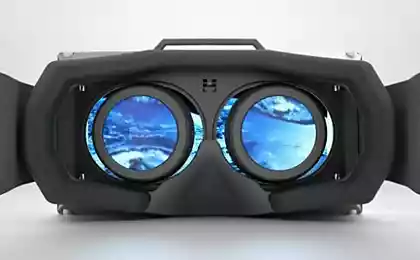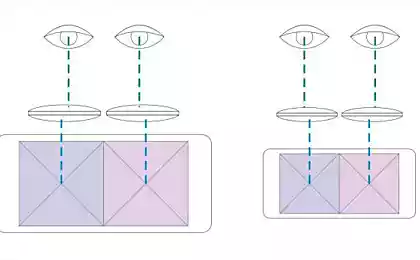472
How the brain responds to virtual reality

Nanofizika the University of California in Los Angeles continue to explore the brain in virtual reality. Not so long ago, they found that the neurons of the brain responsible for mapping space, react to virtual reality as in real conditions. The findings of scientists can be important for people who use virtual reality for gaming, military simulators, commercial, scientific purposes and other purposes.
"The pattern of activity of a brain area involved in spatial orientation in a virtual world, completely different than during the processing activity in the real world — told Mayank Mehta, Professor of physics, neurology and neurobiology, University of California, lead author of the work. — As more people use virtual reality, it is important to understand why there is such a big difference."
Scientists studied the hippocampus, a brain region involved in diseases such as Alzheimer's, stroke, depression, schizophrenia, epilepsy and PTSD. The hippocampus also plays an important role in forming new memories and creating mental maps of space. For example, when a person explores a room, hippocampal neurons become selectively active, creating a "cognitive map" of the environment.
The mechanism by which the brain creates cognitive maps remains a mystery, but neuroscientists suggest that the hippocampus computes the distance between the subject and surrounding sites, for example, buildings and mountains. Other signals, like smells and sounds can also help the brain determine distances to objects.
To test whether the hippocampus is actually to form a spatial map only on visual landmarks, the Meta team has developed a noninvasive virtual reality environment and studied how the hippocampal neurons in the brains of rats reacted in the virtual world without the ability to use smells and sounds as cues.
Scientists placed rats on a treadmill surrounded by a "virtual world" on large video screens — this dive was even more powerful than IMAX — in a quiet dark room. Then measured the behavior of rats and the activity of hundreds of hippocampal neurons. Also the subject of measurements was the behaviour of rats and neural activity when they were moving in a real room, which looked exactly like a virtual.
Scientists were surprised to find that the results of virtual and real environments were completely different. In the virtual world, the hippocampal neurons of rats triggered accidentally, like he didn't have the slightest idea where there were rats — rats though they behaved quite normally in the real and virtual worlds.
"Map" is completely gone, — said Meta. — No one saw this coming. The activity of neurons randomly determined the position of the rats in the virtual world".
Zahra the Agajan, a graduate student at the University of California and is also the author of the work, said: "a Careful mathematical analysis showed that neurons in the virtual world was calculated distance that passed rats, regardless of where they were in virtual space".
Also, scientists were shocked to discover that although the hippocampal neurons of rats was very active in the real environment, more than half of them passed out in a virtual environment. The virtual world used in the study were very similar to the virtual reality environment used by humans, and neurons in the brain of rats would be very difficult to distinguish from neurons in the human brain, says Meta. "Neural model in virtual reality is substantially different from the pattern of activity in the real world. We need to fully understand how virtual reality affects the brain."
In addition to analyzing the activity of individual neurons, the Meta team has studied a large group of brain cells. The previous study showed that a group of neurons creates a complex pattern using brain rhythms.
"These complex rhythms are crucial for learning and memory, but we can't hear or see these rhythms in my head. They are hidden from us, — said Meta. — Complex pattern they create is not amenable to human interpretation. Neurons in the region responsible for memory, communicate with each other using two different languages at the same time. One language is based on rhythm, different in intensity."
Meta says that every neuron in the hippocampus speaks the two languages at the same time comparing this phenomenon with many simultaneously sounding melodies in the Fugue by Bach. Scientists say that in the virtual environment, the language of the rhythms has a similar structure that is in the real world, even if it tells something entirely different in each world. However, the language based on intensity, completely destroyed.
When people walk or try to remember something, the activity in the hippocampus becomes very rhythmic, and there is a complex pattern of rhythms, says Meta. These rhythms contribute to the formation of memories and our ability to call them. Meta suggests that some people with memory disorders, these rhythms are impaired.
"Neurons involved in memory interact with other parts of the hippocampus like an orchestra, says Meta. — Even if every violinist and every trumpet player would play his part perfectly, they must be perfectly synchronized".
Meta believes that rebuilding and synchronizing these rhythms, doctors will be able to repair damaged memory, but it will be very difficult. Neurons and synapses — connections between neurons — are incredibly complex machines.
Any scientists conduct experiments on rats, because people conduct these types of surveys it is impossible and unethical — at least for the moment.
Source: hi-news.ru
Forgotten properties of celandine in the treatment of cancer and not only
Archaeologists have discovered an ancient farm right in the center of Israel























